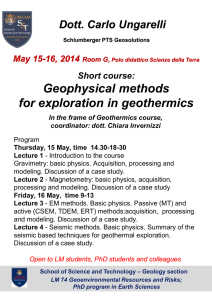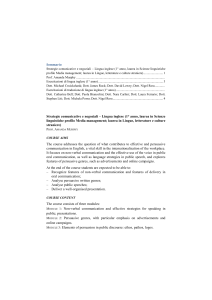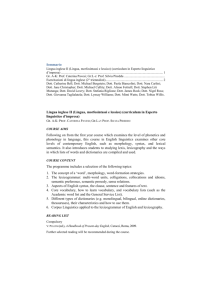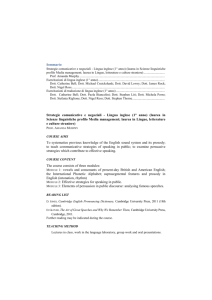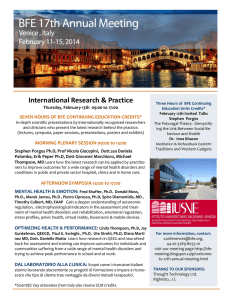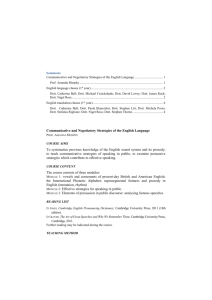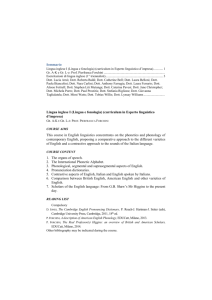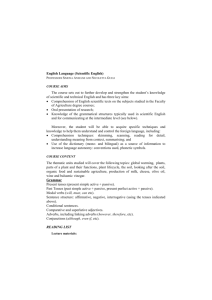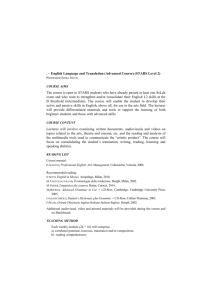Esercitazioni di lingua inglese (3° triennalisti)
advertisement
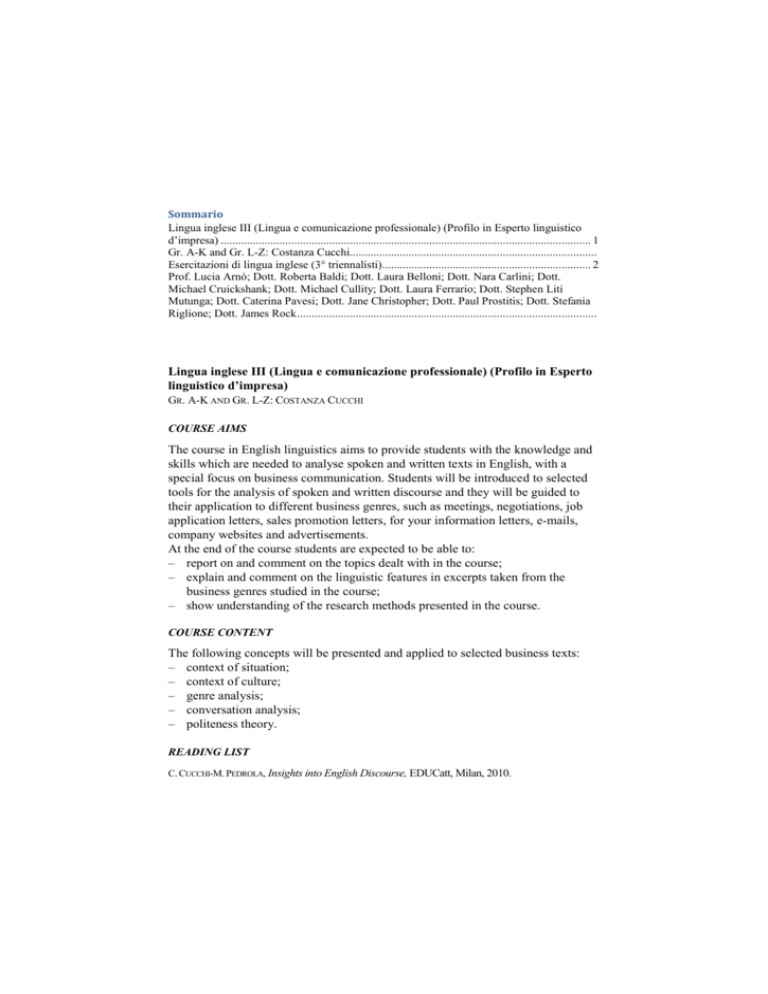
Sommario Lingua inglese III (Lingua e comunicazione professionale) (Profilo in Esperto linguistico d’impresa) .............................................................................................................................. 1 Gr. A-K and Gr. L-Z: Costanza Cucchi.................................................................................... Esercitazioni di lingua inglese (3° triennalisti)....................................................................... 2 Prof. Lucia Arnò; Dott. Roberta Baldi; Dott. Laura Belloni; Dott. Nara Carlini; Dott. Michael Cruickshank; Dott. Michael Cullity; Dott. Laura Ferrario; Dott. Stephen Liti Mutunga; Dott. Caterina Pavesi; Dott. Jane Christopher; Dott. Paul Prostitis; Dott. Stefania Riglione; Dott. James Rock ...................................................................................................... Lingua inglese III (Lingua e comunicazione professionale) (Profilo in Esperto linguistico d’impresa) GR. A-K AND GR. L-Z: COSTANZA CUCCHI COURSE AIMS The course in English linguistics aims to provide students with the knowledge and skills which are needed to analyse spoken and written texts in English, with a special focus on business communication. Students will be introduced to selected tools for the analysis of spoken and written discourse and they will be guided to their application to different business genres, such as meetings, negotiations, job application letters, sales promotion letters, for your information letters, e-mails, company websites and advertisements. At the end of the course students are expected to be able to: – report on and comment on the topics dealt with in the course; – explain and comment on the linguistic features in excerpts taken from the business genres studied in the course; – show understanding of the research methods presented in the course. COURSE CONTENT The following concepts will be presented and applied to selected business texts: – context of situation; – context of culture; – genre analysis; – conversation analysis; – politeness theory. READING LIST C. CUCCHI-M. PEDROLA, Insights into English Discourse, EDUCatt, Milan, 2010. C. CUCCHI-A. MURPHY, Spoken and Written Communication at Work, EDUCatt, Milan, 2011. C. CUCCHI-A. MURPHY, Perspectives on Discourse, EDUCatt, Milan, 2009. A. KOESTER, Investigating Workplace Discourse, Routledge, London, 2006. TEACHING METHOD Lectures in class, guided discussion, group work and oral presentations by the students. ASSESSMENT METHOD – – Continuous assessment with a final oral exam. The final mark will be calculated taking into consideration: the candidate’s ability to : report on and comment on the topics dealt with in the course; explain and comment on the linguistic features in excerpts taken from the business genres studied in the course; show understanding of the research methods presented in the course; the candidate’s communicative competence. NOTES The final mark for English Language III (Language and Professional Communication) (13 CFU) represents both the language exams (i.e. the written and oral prove intermedie) and the English linguistics exam for this course (Professional Communication). With the exception of incoming Erasmus students from other universities, students must pass the language exams before they take the linguistics exam. For Erasmus students, the Professional Communication course (30 hours) is worth 5 CFU. Place and time of consultation hours During the semester, Prof Cucchi’s office hours take place on a weekly basis, according to the notices in the Dept of Scienze linguistiche e letterature straniere (Via Necchi 9, III and IV floor). Timetable variations will be communicated through her university webpage. Esercitazioni di lingua inglese (3° triennalisti) PROF. LUCIA ARNÒ; DOTT. ROBERTA BALDI; DOTT. LAURA BELLONI; DOTT. NARA CARLINI; DOTT. MICHAEL CRUICKSHANK; DOTT. MICHAEL CULLITY; DOTT. LAURA FERRARIO; DOTT. STEPHEN LITI MUTUNGA; DOTT. CATERINA PAVESI; DOTT. JANE CHRISTOPHER; DOTT. PAUL PROSTITIS; DOTT. STEFANIA RIGLIONE; DOTT. JAMES ROCK COURSE AIM The general aim of the course is to provide students with detailed knowledge of the characteristics of the texts and vocabulary appropriate to their curriculum, and to develop their oral and written language competence in areas useful to their professional development. Particular attention is directed towards vocabulary and idiomatic usage. COURSE CONTENT Students work on a range of up-to-date materials prepared by their teachers specifically for their curricula, including passages for reading comprehension from newspapers and online sources, presented in various formats, including written texts, advertisements, audio files. The course also offers an important translation component, both into English and into Italian, in which authentic texts which are relevant to their field of study are translated in class and at home. READING LIST Students should possess both a monolingual and a bilingual dictionary. Recommended bilingual dictionaries: Il Sansoni Italiano-Inglese, Sansoni, 2010, 5th ed. Grande Dizionario Hoepli Inglese con CD-ROM, Hoepli, 2007. Il Dizionario Inglese Italiano Ragazzini, Zanichelli, 2012. Oxford Paravia. Il dizionario inglese-italiano, italiano-inglese. 2006. 2nd ed. Recommended Monolingual dictionaries: Advanced Dictionary, Collins Cobuild, 2008, 6th ed. Advanced Learners Dictionary, Cambridge, 2010, 3rd ed. Advanced Learners Dictionary, Oxford, 2010, 8th ed. English Dictionary for Advanced Learners, Macmillan, 2007, 2nd ed. Longman Dictionary of Contemporary English, 2010, 4th ed. Other useful reading: C. TAYLOR, Language to Language, Cambridge University Press, Cambridge, 1998. TEACHING METHOD Lessons in the classroom, self-study using selected materials on the Blackboard platform and in the multimedia labs. ASSESSMENT METHOD The language exams are called prove intermedie (intermediate tests) to indicate that they are a step towards the end of year exam in either English Linguistics or English Literature, according to the student’s curriculum. The grades in the written and oral language exams contribute to the final single mark awarded for the whole first year programme. The third year written language exam is in two parts. Part 1 consists of two translations, one from English to Italian, the other from Italian to English. In Part 1, both monolingual and bilingual dictionaries may be used, but not special dictionaries (such as exam dictionaries or collocations dictionaries). Part 2 consists of a reading comprehension, a writing exercise, such as drawing up a letter of various types (such as a job application letter or a complaint letter), and the last part of the exam consists of a listening comprehension with a gap-fill test. Dictionaries may not be used in Part 2. At the oral exam, students must be able to discuss readings selected during the year. Listening and speaking skills are assessed in a face-to-face conversation, together with pronunciation, communicative fluency, grammatical accuracy, use of appropriate vocabulary and the ability to interact. Students must demonstrate that they know the contents of the readings and are able to discuss related themes. AVVERTENZE It is important that students remain in the course assigned to them so as to ensure evenly-sized lanaguage courses. Any students who do not succeed in passing their written exams are required to attend the remedial courses (corso di recupero) in the following semester. Place and time of consultation hours The language teachers are available to talk to students after lessons.
